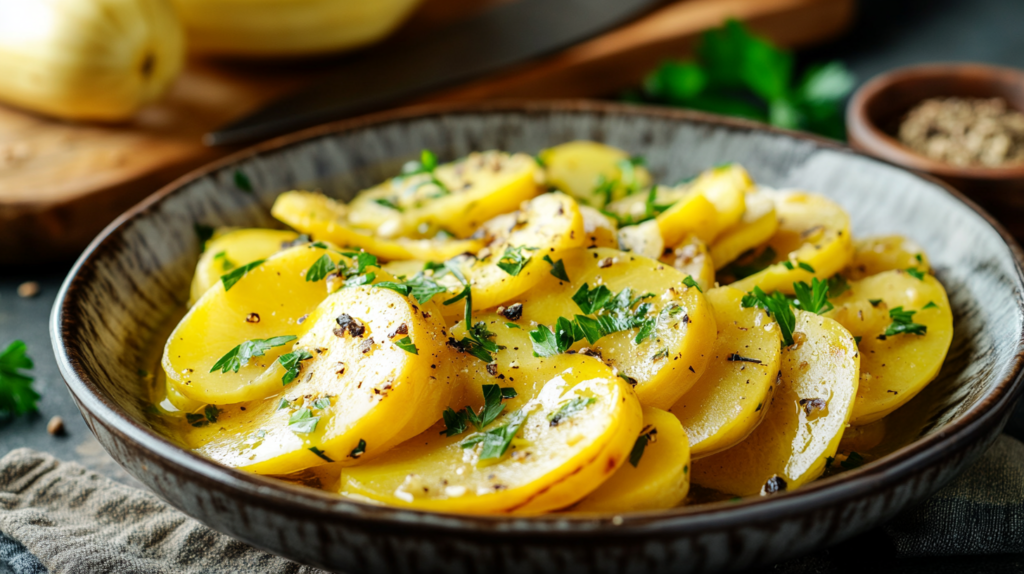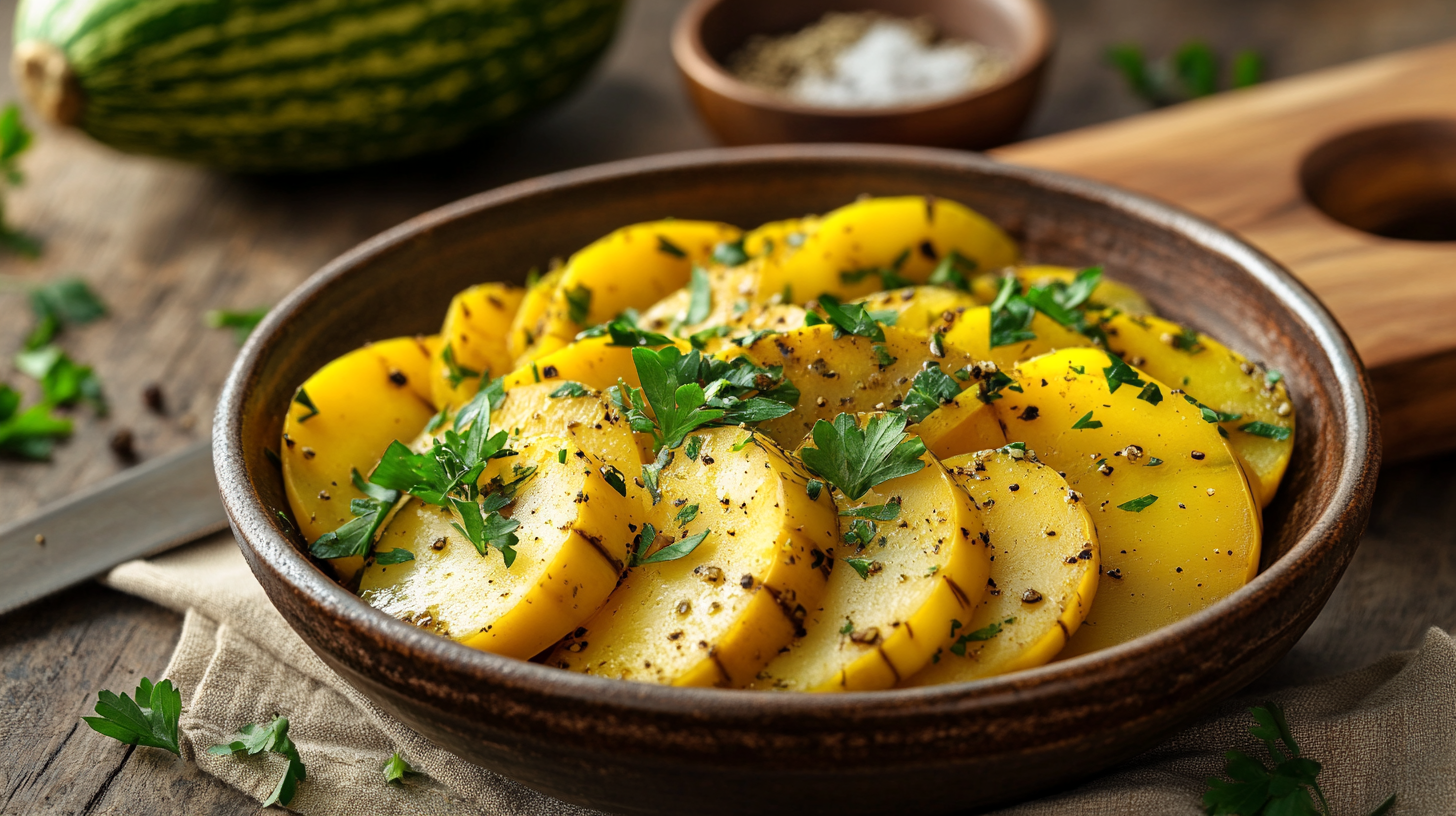Chayote may not be the most well-known vegetable, but it deserves a place in every kitchen. With its mild flavor, crisp texture, and versatility, chayote is an excellent ingredient for soups, salads, stir-fries, and even baked dishes. Whether you’re looking for healthy meal ideas, traditional recipes, or creative ways to cook chayote, this guide will help you make the most of this underappreciated squash.
What is Chayote? A Guide to This Versatile Ingredient
Before we get into the recipes, let’s take a closer look at what chayote is and why it’s worth adding to your diet.
The Origins and History of Chayote
Chayote, also known as vegetable pear, mirliton, or sayote, is a type of squash native to Central America and Mexico. It has been cultivated for centuries and remains a staple in Mexican, Caribbean, and Southeast Asian cuisines.
This green, wrinkled squash is part of the gourd family, related to cucumbers, zucchini, and pumpkins. Unlike some squashes, chayote has a mild taste and a crisp texture, making it adaptable to both raw and cooked dishes.
“Chayote is like a blank canvas—it absorbs flavors beautifully and can be used in both savory and sweet recipes.”
Nutritional Benefits of Chayote and Why You Should Eat It
Not only is chayote low in calories, but it is also packed with essential nutrients. Here’s why it’s a great addition to any diet:
- Low in Calories: A single cup of chayote contains only about 25 calories, making it perfect for weight-conscious eaters.
- Rich in Fiber: Helps improve digestion and keeps you full longer.
- High in Vitamin C: Boosts immune function and promotes healthy skin.
- Good Source of Folate: Essential for cell growth and beneficial for pregnant women.
- Supports Heart Health: Contains potassium and antioxidants that help regulate blood pressure.
If you’re looking for a nutritious, low-carb, and refreshing vegetable, chayote is an excellent choice.
How to Prepare Chayote for Cooking

Chayote is easy to prepare, but knowing the best way to handle it will make cooking much simpler.
Choosing the Best Chayote: Freshness and Ripeness Tips
When shopping for chayote, look for firm, smooth-skinned squash without any soft spots. Unlike some other vegetables, chayote is always picked unripe, so it doesn’t need additional ripening at home.
Best chayote selection tips:
- The skin should be bright green, with minimal blemishes.
- It should feel firm to the touch, not soft or wrinkled.
- Smaller chayotes tend to be tenderer and less fibrous than larger ones.
How to Peel, Cut, and Store Chayote Properly
Unlike some squashes, chayote has thin, edible skin. You can peel it, but it’s not necessary unless you prefer a softer texture.
How to Cut Chayote:
- Wash and dry the chayote.
- Cut it in half lengthwise and remove the large seed inside.
- Slice or dice it depending on the recipe.
Storage Tips:
- Keep chayote in the refrigerator for up to two weeks.
- Once cut, store pieces in an airtight container and use them within 3–5 days.
“Chayote is a meal prep favorite—it stays fresh for a long time and holds its texture well in any dish.”
Classic Chayote Recipes for Every Meal
Now, let’s get into some simple and delicious ways to cook chayote.
Sautéed Chayote with Garlic and Herbs
This is one of the easiest ways to cook chayote. A quick sauté with garlic, herbs, and olive oil brings out its mild, slightly nutty flavor.
Ingredients:
- 2 chayotes, sliced
- 1 tablespoon olive oil
- 2 cloves garlic, minced
- ½ teaspoon salt
- ¼ teaspoon black pepper
- 1 teaspoon fresh parsley, chopped
Instructions:
- Heat olive oil in a pan over medium heat.
- Add minced garlic and cook until fragrant.
- Toss in the sliced chayote, salt, and pepper.
- Sauté for 5–7 minutes, stirring occasionally.
- Sprinkle with parsley and serve warm.
Chayote Salad with Citrus Dressing
If you prefer raw chayote, this refreshing salad is a great option.
Ingredients:
- 1 chayote, julienned
- ½ cup cherry tomatoes, halved
- ¼ red onion, thinly sliced
- 2 tablespoons lime juice
- 1 tablespoon olive oil
- ½ teaspoon salt
- ¼ teaspoon black pepper
Instructions:
- Combine chayote, tomatoes, and red onion in a bowl.
- In a small dish, whisk together lime juice, olive oil, salt, and pepper.
- Drizzle over the salad and toss well.
- Serve immediately for a fresh, crisp bite.
Creamy Chayote Soup for a Comforting Meal
Chayote is perfect for soups because of its light, velvety texture.
Ingredients:
- 2 chayotes, diced
- 1 small onion, chopped
- 2 cloves garlic, minced
- 2 cups vegetable broth
- 1 cup milk (or coconut milk for a dairy-free version)
- ½ teaspoon salt
- ¼ teaspoon nutmeg (optional)
Instructions:
- Sauté onion and garlic in a pot until softened.
- Add diced chayote and cook for 5 minutes.
- Pour in vegetable broth and let simmer for 15 minutes.
- Blend the soup until smooth, then return to heat.
- Stir in milk and season with salt and nutmeg.
- Serve warm with crusty bread.
“Chayote’s mild taste makes it a great addition to creamy soups—it blends into a smooth, comforting texture with a hint of sweetness.”

Healthy and Low-Calorie Chayote Recipes
Chayote is naturally low in calories, high in fiber, and packed with nutrients, making it an excellent ingredient for those following a healthy diet. Whether you’re looking for a light side dish or a low-carb meal, these recipes are both nutritious and satisfying.
Steamed Chayote with Olive Oil and Lemon
Steaming chayote preserves its crisp texture and mild flavor while keeping the dish light and simple.
Ingredients:
- 2 chayotes, sliced
- 1 tablespoon olive oil
- 1 tablespoon lemon juice
- ½ teaspoon salt
- ¼ teaspoon black pepper
Instructions:
- Steam chayote slices for 5–7 minutes until tender but still firm.
- Transfer to a bowl and drizzle with olive oil and lemon juice.
- Sprinkle with salt and pepper, then toss gently.
- Serve warm or chilled.
“Steamed chayote is the perfect side dish—light, refreshing, and pairs well with any protein.”
Chayote Stir-Fry with Tofu and Vegetables
This quick stir-fry is loaded with fiber, protein, and vitamins, making it a great vegetarian meal.
Ingredients:
- 1 chayote, julienned
- ½ block firm tofu, cubed
- 1 red bell pepper, sliced
- 1 small onion, chopped
- 2 cloves garlic, minced
- 1 tablespoon soy sauce
- 1 teaspoon sesame oil
Instructions:
- Heat sesame oil in a pan over medium heat.
- Add tofu cubes and cook until golden brown, then remove and set aside.
- Sauté garlic and onion until fragrant.
- Add chayote and bell pepper, stirring for 5 minutes.
- Return tofu to the pan, add soy sauce, and stir well.
- Serve hot with brown rice or quinoa.
Roasted Chayote with Spices and Herbs
Roasting brings out chayote’s natural sweetness while adding a slightly crispy texture.
Ingredients:
- 2 chayotes, cubed
- 1 tablespoon olive oil
- ½ teaspoon paprika
- ½ teaspoon garlic powder
- ½ teaspoon dried oregano
- ½ teaspoon salt
Instructions:
- Preheat oven to 400°F (200°C).
- Toss chayote cubes with olive oil, paprika, garlic powder, oregano, and salt.
- Spread evenly on a baking sheet and roast for 20–25 minutes, flipping halfway.
- Serve warm as a healthy side dish.
“Roasting chayote enhances its natural flavors, making it a great substitute for roasted potatoes or squash.”
Chayote in International Cuisine
Chayote is used in various cultures around the world, with each region adding its own unique flavors and techniques to highlight this squash.
Mexican Chayote Recipes: Traditional Dishes and Flavors
In Mexico, chayote is commonly cooked in soups, stews, and salads. One popular dish is chayote con queso, where steamed chayote is topped with melted cheese and spices.
Quick Mexican-Style Chayote Recipe:
- Steam chayote halves until soft.
- Sprinkle with cumin, salt, and chili powder.
- Top with grated queso fresco and serve warm.
Chayote in Filipino Cooking: Ginisang Sayote Recipe
In Filipino cuisine, ginisang sayote (sautéed chayote) is a common dish, often served with shrimp or ground meat.
Ingredients:
- 2 chayotes, julienned
- ½ pound shrimp or ground beef
- 2 cloves garlic, minced
- 1 onion, chopped
- 1 tablespoon fish sauce
- ½ teaspoon black pepper
Instructions:
- Sauté garlic and onion in a pan until fragrant.
- Add shrimp or ground beef and cook until browned.
- Stir in chayote and cook for 5 minutes.
- Add fish sauce and black pepper, then mix well.
- Serve hot with steamed rice.
French-Inspired Chayote Gratin
Chayote is sometimes used in French-inspired gratin dishes, layered with cheese, cream, and breadcrumbs for a rich, comforting side.
Ingredients:
- 2 chayotes, thinly sliced
- 1 cup heavy cream
- ½ cup grated Gruyère or Parmesan cheese
- ½ teaspoon salt
- ¼ teaspoon nutmeg
- ¼ cup breadcrumbs
Instructions:
- Preheat oven to 375°F (190°C).
- Arrange chayote slices in a greased baking dish.
- Mix cream, cheese, salt, and nutmeg, then pour over the chayote.
- Sprinkle breadcrumbs on top and bake for 25–30 minutes until golden brown.
“Chayote gratin is a creamy, cheesy delight that pairs well with roasted meats or grilled fish.”
Common Problems When Cooking Chayote (And How to Fix Them)
Even though chayote is easy to cook, a few common mistakes can affect the final dish. Here’s how to fix them.
Why Is My Chayote Too Watery?
- Possible Cause: Chayote releases water while cooking.
- Solution: Sauté or roast at higher temperatures to allow excess moisture to evaporate.
How to Prevent Chayote from Being Too Bland
- Possible Cause: Chayote has a mild, neutral taste.
- Solution: Use bold seasonings, fresh herbs, and citrus juices to enhance flavor.
Best Ways to Enhance the Flavor of Chayote
- Roasting or grilling gives it a slightly caramelized taste.
- Pairing with strong flavors like garlic, onions, and cheese makes it more dynamic.
- Cooking in broth or sauces helps it absorb seasonings better.
“Chayote is mild on its own, but the right seasonings and cooking methods can bring out incredible flavors.”
Creative Ways to Use Chayote in Everyday Cooking
Chayote is an incredibly adaptable ingredient, and beyond traditional recipes, there are plenty of creative ways to include it in your meals.
Adding Chayote to Smoothies for Extra Nutrition
Since chayote has a mild taste, it blends well into smoothies without overpowering other flavors. It also adds fiber, hydration, and a creamy texture.
How to Make a Chayote Smoothie:
- 1 cup chayote (peeled and diced)
- 1 banana
- 1/2 cup Greek yogurt
- 1/2 cup almond milk
- 1 tablespoon honey or maple syrup
- Ice cubes
Instructions:
- Blend all ingredients until smooth.
- Serve immediately for a refreshing and nutritious drink.
“Chayote is a great way to add fiber and nutrients to your smoothie without affecting the taste.”
Using Chayote as a Low-Carb Pasta Alternative
Chayote can be spiralized or sliced into thin strips to replace pasta or noodles in various dishes.
How to Make Chayote Noodles:
- Peel and julienne the chayote into thin strips.
- Boil or sauté for 2–3 minutes until tender.
- Use as a base for pasta sauces like marinara, pesto, or Alfredo.
This is a perfect low-carb, gluten-free option for pasta lovers.
Chayote Pickles: A Unique and Tangy Treat
Pickled chayote makes a great condiment for tacos, sandwiches, or rice dishes.
Ingredients:
- 2 chayotes, thinly sliced
- 1 cup white vinegar
- ½ cup water
- 1 tablespoon sugar
- 1 teaspoon salt
- 1 clove garlic, minced
- ½ teaspoon red pepper flakes
Instructions:
- In a saucepan, heat vinegar, water, sugar, salt, garlic, and red pepper flakes until dissolved.
- Pour over the sliced chayote in a jar.
- Let cool and refrigerate for at least 24 hours before using.
“Pickled chayote adds a tangy crunch to any dish and keeps well for weeks in the fridge.”
Best Side Dishes to Pair with Chayote Recipes
Chayote is light and refreshing, making it a great companion to various main courses.
Grains That Complement Chayote Dishes
Pairing chayote with whole grains can turn it into a hearty meal.
- Brown rice or quinoa – Absorbs chayote’s flavors and adds protein.
- Couscous – Works well in salads with chayote.
- Wild rice – Adds an earthy taste to soups and stews.
Protein Options That Work Well with Chayote
Since chayote has a mild flavor, it pairs well with lean and bold proteins.
- Grilled chicken or fish – Light proteins complement chayote’s fresh taste.
- Shrimp or tofu – Adds texture to stir-fries and salads.
- Eggs – Scrambled chayote with eggs is a simple, high-protein dish.
“Chayote is an excellent side for proteins like grilled fish or roasted chicken, adding a fresh and mild contrast to richer flavors.”
Storing and Preserving Chayote for Long-Term Use
If you’ve stocked up on fresh chayote, knowing how to store it properly will help it last longer.
Best Methods for Storing Fresh Chayote
- Refrigeration: Store whole chayote in the fridge for up to two weeks.
- Cut Chayote: Once sliced, place in an airtight container with a paper towel to absorb moisture.
Can You Freeze Chayote? A Step-by-Step Guide
Yes! Chayote can be frozen, though its texture may soften after thawing.
How to Freeze Chayote:
- Peel and slice the chayote into cubes or strips.
- Blanch in boiling water for 2 minutes, then cool in ice water.
- Drain and place in freezer-safe bags.
- Label and store for up to 6 months.
“Freezing chayote is a great way to keep it fresh for soups and stir-fries—just thaw and cook as needed.”
Frequently Asked Questions About Chayote Recipes
Can You Eat Chayote Raw?
Yes! Chayote is safe to eat raw and works well in salads, slaws, or smoothies. It has a crisp texture similar to a cucumber or apple.
What Does Chayote Taste Like?
Chayote has a mild, slightly sweet flavor with a crisp texture. It absorbs other flavors well, making it versatile for various dishes.
Is Chayote Good for Weight Loss?
Yes! Chayote is low in calories, high in fiber, and hydrating, making it an excellent weight-loss-friendly food.
“Chayote is a great low-calorie food that keeps you full and provides essential nutrients without added carbs or fats.”
More Fresh & Healthy Recipes to Try
If you love the mild flavor and versatility of Chayote, here are some other delicious recipes you might enjoy:
- Try this The Ultimate Purple Sweet Potato Recipe for another nutritious and vibrant vegetable dish.
- Looking for a protein-packed, flavorful meal? This Chicken and Shrimp Recipes offers delicious ways to enjoy healthy proteins with fresh ingredients.
- Want a nutrient-rich side dish? This Red Rice Recipe is packed with flavor and pairs perfectly with chayote-based meals.
- If you enjoy fresh and light wraps, check out these Rice Paper Recipes for creative and healthy meal ideas.
- For a refreshing and healthy salad, try this Chick-fil-A Kale Salad Recipe, full of greens and bold flavors.
These recipes will add variety and nutrition to your meals. Try them out and enjoy every fresh and healthy bite!
Final Thoughts: Why You Should Try Chayote in Your Cooking
Chayote is one of the most versatile and nutritious vegetables you can add to your kitchen. Whether you sauté it, roast it, blend it into soups, or eat it raw, it offers endless possibilities for healthy and delicious meals.
To recap:
- Chayote is packed with fiber, vitamins, and antioxidants.
- It works in a variety of cuisines, from Mexican to Filipino and French dishes.
- Creative recipes like smoothies, chayote noodles, and pickled chayote add variety to your meals.
- Proper storage and freezing methods help keep it fresh for longer.
If you haven’t tried cooking with chayote yet, now is the perfect time. Experiment with a new recipe, add it to your favorite dishes, and enjoy its unique texture and flavor.
“Chayote proves that simple ingredients can create extraordinary meals—healthy, delicious, and full of possibilities.”
Happy cooking!

